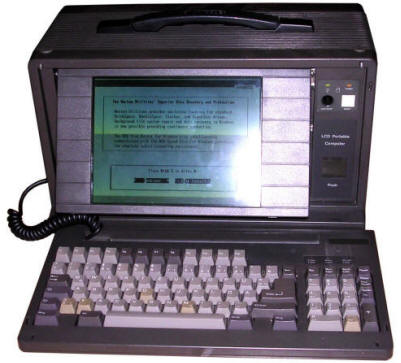Highscreen 386 portable
This portable PC fits in a very specific form factor,
being a small briefcase with detachable keyboard, screen in front and
drives on one side. Although Compaq Portable III - the first widely
spread machine of this form factor, was released around 1987, the
"briefcase" design itself turned to be more resilient than its original
machine. Similar machines were seen in markets even in mid-1990s, mostly
marketed as "Heavy-duty" or "industrial programming" machines. This
386-based computer is from 1992.
What made this design so long-lived even when the laptops became more
popular? The answer is simple: The price. To design a laptop, the form
factor is a tip of the iceberg - you have to design a mainboard, power
supply, use compact drives and energy-efficient low-temperature CPU.
This casing has a small AT-compatible power supply, uses conventional PC
drives and accomodates a typical desktop mainboard inside. The only
non-desktop thing is a video board, built around a specialized Cirrus
Logic CL-GD610/620 chipset with outputs specific for LCD panel. So after
Compaq left their efficient, portable design, mostly Taiwanese companies
started to clone it using PC components. And that's history of these
units.
This unit, manufactured in Taiwan for Highscreen (a Vobis brand) has a 33MHz 386 processor, a math co-processor, 8MB of RAM and 80MB hard disk. As media 3.5" and 5.25" drives are installed. Full 640x480 VGA picture can be shown on grayscale good-contrast LCD panel. With proper settings, the video board can also emulate EGA, Hercules or CGA and use external displays for these. Who purchased these units? They were used as portable computers usually for some equipment, or in all situations where portability was needed, but was not critical. This unit comes from measurement system.
| Manufacturer | Highscreen | |
| Origin | Germany/Taiwan | |
| Year of unit | 1992 | |
| Year of introduction | 199? | |
| Type | PC Portable | |
| CPU | Intel 80386DX 33MHz | |
| RAM | 8MB in SIMM30 modules (8x1MB) |
|
| Floppy Disk | 3.5" 1.44MB 5.25" 1.2MB |
|
| Hard Disk | 81MB Maxtor 7080AT CHS: 981/10/17 |
|
| Other media | None | |
| Graphics and display: | 640x480 VGA grayscale | |
| Sound: | PC Speaker | |
| Keyboard and pointing device: | PC keyboard with numpad OR arrow keys NumLock-switched | |
| OS: | MS-DOS 6.22 | |
|
Power supply: |
||
|
Built-in switching power supply, AT-compatible. |
||
| I/O: | - Serial port x2 - Parallel port - VGA video out - CGA/HGC video out - Game port - Keyboard connector (AT) - Proprietary measurement board connector |
|
| Possible upgrades: | As in typical 386 PC AT | |
| Additional peripherals: | None |
My unit's history is not known well. In 1992, it was
bought in Germany by a company called "TLC-HOGRA" which makes
measurement/test equipment and then modified: The RAM has been expanded,
math co-processor added and soldered-in RTC battery replaced with an
external one. A measurement board has been added for interfacing with
equipment, the board has extended digital I/O as well as analog
measurement converter. It is programmed to application using wires
soldered into its connector. The application did not survive completely
so only incomplete remains were available on disk (a href=MESS.7z>For
research purposes only</a>) and I can't exactly tell what it was used
for, the supplier seems not to be available now too.
When I got this unit, it contained a 1995 TEAC CD-ROM drive instead of
original 1.2MB drive, it was added later during use, probably to read
PDF files using Windows 3.11 and Acrobat Reader 2.0.
The BIOS (contains video
BIOS too) has quite advanced setup routine with memory timings which can
be set too.
The video board is an ISA one which can be used to drive a VGA, CGA or
Hercules monitor as well as internal LCD panel, mirroring the picture.
The board can be configured to a variety of LCD panels - these times
most panels were composed of two independent parts and these parts were
not always equal taking number of lines.
The contrast of LCD panel can be set in two ways - fine-tuning is done
by the trimmer in front of the computer and is usually done by user.
However, if it's not enough, there is another trimmer in the casing of
the power supply unit.
The video board has some unusual construction details not present even in other GD610-based ones. The Video BIOS, when used in VGA mode, switches font from on-RAM to on-ROM, and uses the other half of Video ROM like font RAM. It means that only the on-ROM font can be used in VGA mode - any font uploading in DOS will fail then. This was probably done to make some versions of measurement software boot faster, skipping the specific font loading, but as a result Video ROM shadowing makes the system display distorted characters. So it's needed to turn it off in BIOS when using VGA mode.
The DIP switches are following:
1,2 - monitor spec:
ON, ON - Monochrome
OFF, ON - CGA
ON, OFF - 80x25 text + CGA graphics only
OFF, OFF - VGA.
3,4,5 - LCD panel specification:
ON,ON,ON - Sharp LCD 241/241 lines
OFF,ON,ON - 241/248 lines
ON,OFF,ON - 240/241 lines.
6,7,8 - Graphics emulation mode
OFF,OFF,ON - EGA
OFF,ON,ON - CGA
ON,OFF,ON - Hercules
ON,ON,OFF - VGA
ON,ON,ON - undocumented, behaves like VGA.
All other combinations should cause BIOS to notice about it on some
available screen :).
http://vgamuseum.info/index.php/component/k2/item/127-cirrus-logic-cl-gd610-620-c
- description and good photos of the video board.





